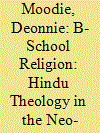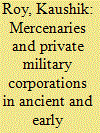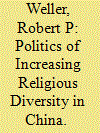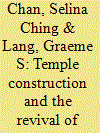|
|
|
Sort Order |
|
|
|
Items / Page
|
|
|
|
|
|
|
| Srl | Item |
| 1 |
ID:
194977


|
|
|
|
|
| Summary/Abstract |
This article argues that even as the legal dispute over the Ram Janmabhumi site remained unresolved for decades, an unimpeded surge in Marwari mercantile financing of new temples for Hanumān, Rāma’s most celebrated devotee, provided the material foundation for a nationwide space exalting Rāma through the worship of Hanumān. Living in the pan-Indian urban diaspora and tracing descent to Rajasthan, Marwari merchants coalesced into devotional organizations dedicated to Hanumān and allied Vaiṣṇava deities (such as Rāma and Kṛṣṇa), initially centered on shrines in Rajasthan itself, from the 1980s on – coeval with the Ram Janmabhumi movement’s escalation. Marwaris had long been known as philanthropists for various social causes, but this article suggests that their philanthropy had evolved by the 1990s. Since the destruction of the Babri mosque at that time, Marwaris funded numerous new temples for Hanumān, in which Rāma was of course also revered. Some Marwaris assumed advisory roles in Hindu activist groups, seemingly embracing a commitment to restore canonical Hindu values eroded by centuries of foreign rule and modern caste politics. This article thus looks at Marwari patronage of deities’ temples as anticipating a post-2019 Ayodhya verdict Hindu devotional geography.
|
|
|
|
|
|
|
|
|
|
|
|
|
|
|
|
| 2 |
ID:
169994


|
|
|
|
|
| Summary/Abstract |
In the industrial sector of Kolkata’s Salt Lake township, the spires, shikaras and domes of religious sites that are interspersed throughout the city proper are absent, and high-rise glass and metal buildings housing multinational corporations, hotels and shopping malls take their place. But religion is not absent there. Instead, management professors and business leaders transform those buildings into temples by framing the labour that takes place within them as a sacrificial act of worship. With this case study, I demonstrate that Hindu theologies are actively shaping and being reshaped by neo-liberal capitalism and its urban topologies.
|
|
|
|
|
|
|
|
|
|
|
|
|
|
|
|
| 3 |
ID:
188314


|
|
|
|
|
| Summary/Abstract |
In India, from the time of emergence of empires in circa 300 BCE till the rise of British power in eighteenth century, military mercenaries and private military companies dominated the politico-military landscape. Premodern India had both secular (military guilds) and religious (based on temples and akharas) military corporations. The mercenaries were mostly marginal peasants and demobilised soldiers. They were hired through the agency of their clan leaders, tribal chieftains or the zamindars (large landlords) in whose villages they resided. Historians argue that the presence of the mercenaries and extra state military corporations prevented the rise of strong states in premodern India. In this paper, based mostly on indigenous sources, I argue that the military mercenaries and the private military corporations of pre-British India were at the forefront of technological development. The mercenaries were the channel through which tools, techniques, and ideas of warfare were transferred. The rulers relied on the mercenaries because of their military skills and in the long run they also proved to be cheaper compared to the cost of maintaining permanently a large regular army.
|
|
|
|
|
|
|
|
|
|
|
|
|
|
|
|
| 4 |
ID:
130450


|
|
|
|
|
| Publication |
2014.
|
| Summary/Abstract |
China has seen a remarkable growth and pluralization of religious activity over the past thirty years, a development that has rapidly overtaken the incremental and sluggish changes in the relevant regulatory structures. In much of the country, the government has managed the mismatch between religious practice and official rules by governing with "one eye open and one eye closed," that is, by pretending not to notice violations of the regulations as long as people pretend that they are following the rules. Comparative evidence suggests that such a mode of governance can be long-lasting and effective by encouraging groups to self-censor, by allowing space for contextual experimentation, and by stressing the acceptance of nominal convention over the control of behavior. This situation is likely to continue unless China adopts a new vision of the desired relation between state and society.
|
|
|
|
|
|
|
|
|
|
|
|
|
|
|
|
| 5 |
ID:
076887


|
|
|
|
|
| Publication |
2007.
|
| Summary/Abstract |
This article examines a case of temple construction that was initiated by officials and cadres rather than by locals. The temple construction and religious revival are analyzed in the light of complex dynamics between the cadres at the United Front, provincial office, municipal government, township office, and religious bureau, as well as between these cadres and the locals-the intellectuals, village elders, religious specialists, and villagers. For the cadres and officials, the temple was intended as local heritage to attract tourists and ultimately to boost the local economy. However, the temple did not draw sufficient visitors as planned, whether foreign or local. On the other hand, the popularity of the deity associated with the temple took off. We suggest that whether the villagers identify culturally with the temple and lend it their support is crucial in determining its success. The fate of the temple will hence depend ultimately on the ability of the management committee to mobilize and involve local networks in the temple's activities.
|
|
|
|
|
|
|
|
|
|
|
|
|
|
|
|
|
|
|
|
|